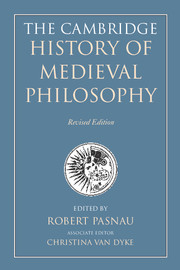Book contents
- Frontmatter
- Contents of Volume 1
- Preface
- List of contributors
- Frontmatter
- Contents of Volume 2
- Introduction
- I Fundamentals
- II Logic and language
- III Natural philosophy
- IV Soul and knowledge
- V Will and desire
- VI Ethics
- VII Political philosophy
- VIII Metaphysics
- IX Theology
- Appendices
- Appendix A DOCTRINAL CREEDS
- Appendix B MEDIEVAL TRANSLATIONS
- Appendix C BIOGRAPHIES OF MEDIEVAL AUTHORS
- Bibliography of primary sources
- Bibliography of secondary sources
- Index nominum
- Index rerum
Appendix A - DOCTRINAL CREEDS
from Appendices
Published online by Cambridge University Press: 05 August 2014
- Frontmatter
- Contents of Volume 1
- Preface
- List of contributors
- Frontmatter
- Contents of Volume 2
- Introduction
- I Fundamentals
- II Logic and language
- III Natural philosophy
- IV Soul and knowledge
- V Will and desire
- VI Ethics
- VII Political philosophy
- VIII Metaphysics
- IX Theology
- Appendices
- Appendix A DOCTRINAL CREEDS
- Appendix B MEDIEVAL TRANSLATIONS
- Appendix C BIOGRAPHIES OF MEDIEVAL AUTHORS
- Bibliography of primary sources
- Bibliography of secondary sources
- Index nominum
- Index rerum
Summary
THE NICENE CREED
THOMAS WILLIAMS
The Nicene Creed was adopted by the First Council of Nicaea (325) and revised by the First Council of Constantinople (381). Its original Greek text was in the first-person plural – “We believe” – reflecting the Creed’s role as a statement of the essential faith of the Church. The most familiar Latin text, however, is in the first-person singular, recited by the priest alone at a time when the people no longer participated vocally in the Eucharistic liturgy. A strictly literal translation of the Latin text is given below.
For medieval Christians, the Nicene Creed held a unique status as a touchstone of orthodoxy. As the statement of ecumenical councils held by the undivided Church, it was (and remains) preeminently authoritative. There was nothing comparable in medieval Judaism and Islam, which had no authoritative mechanism or centralized hierarchy for determining the boundaries of correct belief.
I believe in one God, the Father omnipotent, Maker of heaven and earth, and of all things visible and invisible.
And [I believe] in one Lord, Jesus Christ, the only-begotten Son of God, and born from the Father before all ages: God from God, Light from Light, true God from true God; begotten, not made; consubstantial with the Father. Through him all things were made. For the sake of (propter) us human beings, and for the sake of our salvation, he descended from heaven. And he was incarnate by the Holy Spirit from the Virgin Mary, and became human (homo factus est). He was also crucified for us under Pontius Pilate, suffered, and was buried. And on the third day he rose again in accordance with the Scriptures. And he ascended into heaven [and] sits at the right hand of the Father. And he will come again with glory to judge the living and the dead. His kingdom will have no end.
And [I believe] in the Holy Spirit, the Lord and Life-giver, who proceeds from the Father and the Son. He is worshiped and glorified together with the Father and the Son. He has spoken through the prophets. And [I believe] one holy, catholic, and apostolic Church. I acknowledge one baptism unto remission of sins. And I look for the resurrection of the dead and the life of the age to come. Amen.
- Type
- Chapter
- Information
- The Cambridge History of Medieval Philosophy , pp. 787 - 792Publisher: Cambridge University PressPrint publication year: 2014



